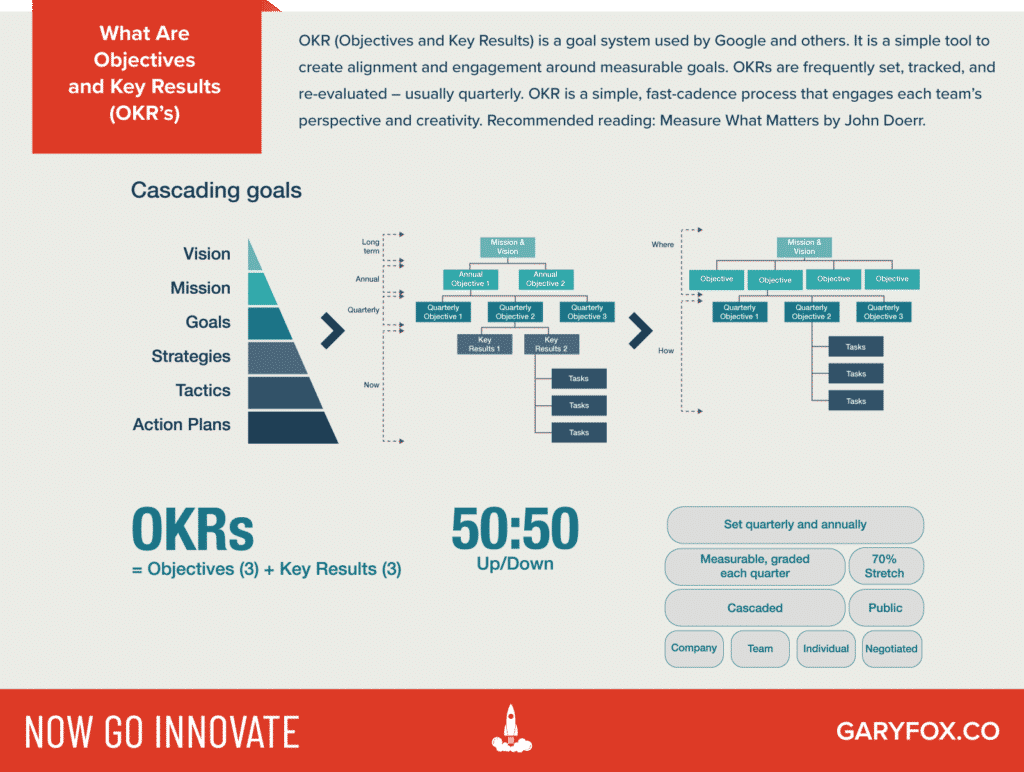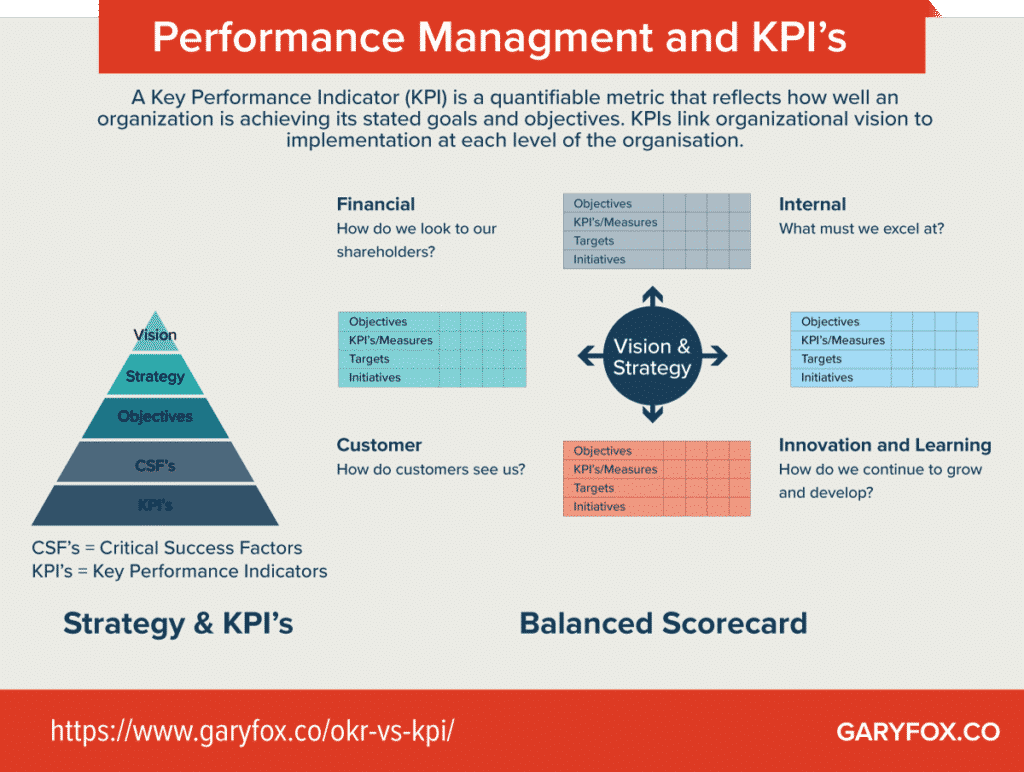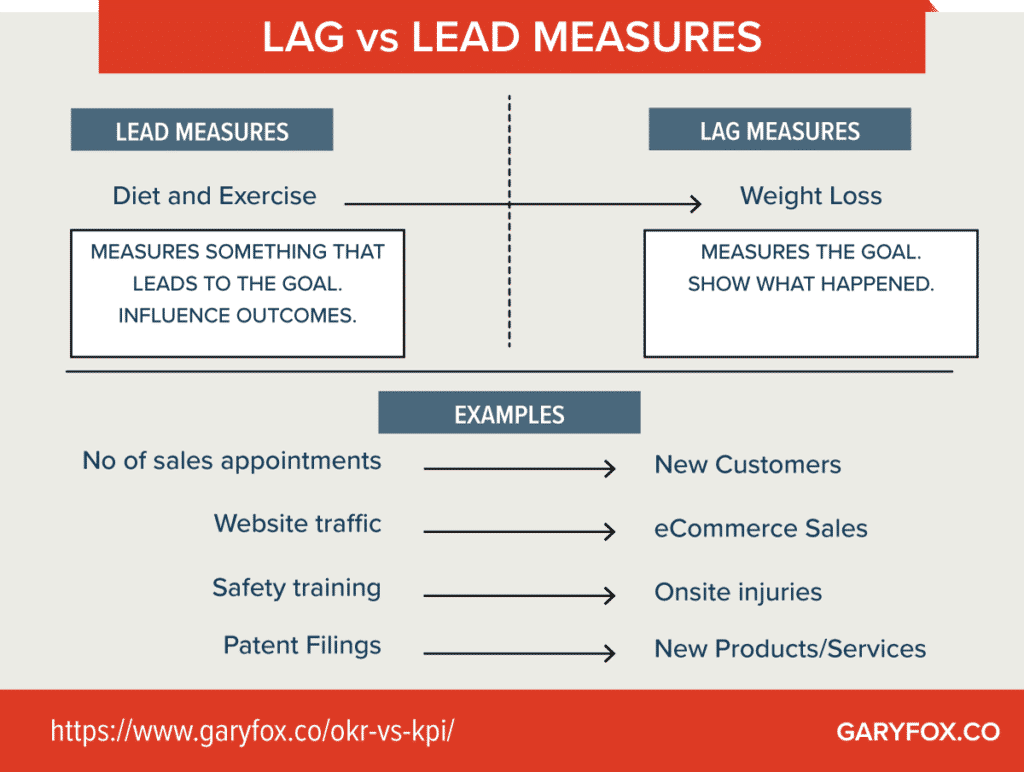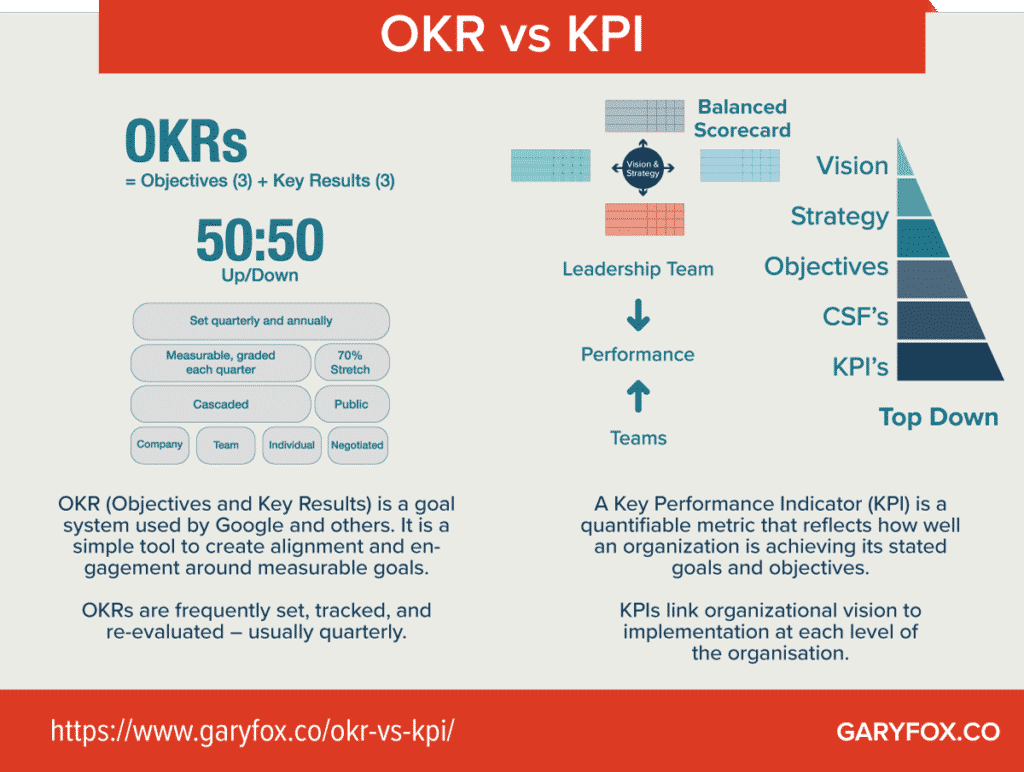OKR vs KPI – a guide to understand how they differ and how they can work together.
So what is the difference between OKR vs KPI?
First of all, let’s just explore a few questions – think of it as setting the scene for reading on, rather than just hopping around looking for a simple solution.
After strategy comes implementation. That’s where the rubber hits the road, where the culture, operations and management of the business have to come together.
The thing is though that organisations – of all sizes – are messy – full of social interactions, attitudes, opinions, emotions. So how do you know when things are working and when they aren’t?
As a leader, you have your hand’s full balancing between looking at what comes next and what is happening now.
Unless you have a system in place, a way to track and steer progress your strategy is worth zero.
Managing a business means measuring the right things – not just anything though. That’s where KPI’s come in. But how do your teams understand what they need to do?
How do you align them to where you want the business to go?
Well, by using OKR’s you work with your teams – not simply top-down – you provide them with the tools to understand what they need to achieve and then they decide the how – simple right!
So we need to measure the right things and to set objectives at different levels of the business – but allow teams to do the objective setting like a cascade so it all knits together. Instead of thinking OKR vs KPI it should be OKR and KPI.
Table of Contents
OKR vs KPI Explanation
Before we dive into the main differences and how they work together. It’s important to get a balance with setting and measuring what’s important at the strategic level of a business as well as across different business units.
The wrong measures can easily drive the wrong behaviours. Aligning measures with the mission, vision and values of an organisation help ensure consistency of behaviours and performance.
What Are OKR’s?
OKR’s stand for Objectives and Key Results which together form the framework for setting and achieving objectives as a company, team and individual. The OKR framework knits together across all levels of the business the strategy and how it is achieved.
The OKR formula is: “I will __ (Objective), as measured by __ (Key Results).”

The OKR framework then is a method to set objectives across an organisation that then align with the overall strategy. By regular measuring and tracking performance of the objectives, large organisations can consistently achieve their overall goals.
OKR Framework
- Objective: this needs to be short, clear, aspirational goal, achievable within a given reporting cycle. The Objective should motivate, provide direction, and challenge the team. No jargon and usually no numbers.
- Key Results: are the metrics that measure progress towards achieving your Objective. Each Objective should have between 2 to 5 Key Results.
- Cascade: OKRs cascade, from the senior team to all other business units and teams and (often) to individuals. OKRs are designed to align teams and help them to coordinate actions that result in achieving the objective.
- Result: If all teams hit their objectives and therefore each division consequently hits its objectives, the overall result is that the company achieves its objective.
Example Objective
- Improve Customer Experience Across Channels.
Example Key Results
- Improve Net Promoter Score from X to Y.
- Increase customer acquisition rate across channels from X to Y.
- Reduce customer complaints by X per cent.
Example Initiatives
- Implement new omnichannel CRM system.
- Create content aligned to customer segments.
- Research customers that drop off after X weeks.
Creating high-quality OKRs is a crucial first step. They should be:
- Valuable: OKRs should measure impact and not be merely a list of activities. Focus on Value-based Key Results.
- Engaging: The OKR setting process should engage the creativity and the perspectives of the employees. The OKRs themselves should be inspiring instead of boring.
- Actionable: The team has to understand the metrics and how they relate to each other. If the team does not know what it can do to improve a Key Result, it will never be successful.
What are KPI’s?

KPI stands for Key Performance Indicator. A Key Performance Indicator is a measure that evaluates the progress of a particular activity in an organisation.
In simple terms, it is a measure that is set against a strategic objective and then tracked at regular intervals e.g. monthly, quarterly and annual reports.
First of all, they need to be aligned with the overall strategy. Second, you need to limit them. Repeated research has shown that too often senior managers either 1Hammer, Michael et al. “The 7 Deadly Sins of Performance Measurement and How to Avoid Them.” (2006).
- Measure too many things.
- Measure the wrong things.
Although you can measure anything and everything you shouldn’t just jump in and measure too many things. Key Performance Indicators are a way to filter and focus on measures that matter.
- KPIs are general indicators of performance that focus on critical outcomes.
- Only a limited, manageable number of KPIs is needed. Having too many complicates line management and becomes time-consuming.
- The systematic use of KPIs is essential as the value of KPIs is almost completely derived from their consistent use.
- KPIs should be designed to fit with each different organisation – there is no one size fits all approach to performance indicators.
- For performance measurement to be effective, the indicators must be accepted, understood and owned across the organisation.
- KPIs often need to evolve and it is likely that a set of KPIs will be subject to change and refinement over time.
- Graphic displays of KPIs need to be simple in design, easy to update and accessible.
- Actions and decisions need to be taken as a result of the indicators.
Examples of Key Performance Indicators
Examples of Marketing KPIs
- Number of New Leads Per Period
- Dollar Value for New Leads Signed Per Period
- Number of Qualified Leads Per Period
- Outbound Calls To Leads
- Number of Contract Proposals
- Net Sales – Revenue and/or Percentage Growth
Examples of Financial KPIs
- Growth in Revenue
- Net Profit Margin
- Gross Profit Margin
- Cash Flow
- Current Accounts Receivables
- Inventory Turnover
- EBITDA
Examples of HR KPIs
- Percentage of Job Candidates Who Meet Job Criteria
- Employee Productivity Rate
- Internal Promotions Vs. External Hires
- Average Tenure
- Employee Satisfaction Rate
- Absenteeism Rate
Setting SMART KPIs
Whatever the type of KPIs, you need to make sure that they’re SMART:
- Specific: be clear about what each KPI will measure, and why it’s important.
- Measurable: the KPI must be measurable to a defined standard.
- Achievable: you must be able to deliver on the KPI.
- Relevant: your KPI must measure something that matters and improves performance.
- Time-Bound: it’s achievable within an agreed time frame.
What’s The Difference Between OKR’s and KPI’s
Here is a quick summary table of OKR vs KPI
| OKR’s | KPI’s |
|---|---|
| Objectives and Key Results | Key Performance Indicators |
| Strategy linked to team and individuals | The strategy aligned across divisions and teams. |
| Inform everyone on what’s important to achieve company goals. | Translate strategy into operational activities and processes. |
| Measure progress – more lead than lag measures | Uses both but tends to result in more lag measures |
| Ambitious Goals | Attainable Goals |
| A broad framework that enables clear communications aligned to roles. | Linked to organizational performance – balanced scorecard |
| Bottom-up and Top-Down – 50/50 | Leadership led – Top-Down |
| Growth Orientation | Performance Management Focus |
KPI’s can, in fact, be set for both lag and lead measures.

How To Align KPI’s With OKR’s
This is a simple example just for illustration. how you do it will depend entirely on your strategy, goals and overarching objectives. Needless to say that giving these elements careful thought pays dividends and improves how leaders align people, culture, operations and finances.
You can align the frameworks by using a balanced scorecard for strategic initiatives and then use the OKR framework to cascade the objectives and track them. Essentially, the core metric on the scorecard becomes a measure.
Note: Managing people top-down is not the aim here. OKR’s work and stimulate teams because they have a voice and ideas on how to achieve their objectives. This, in turn, creates a level of organizational agility and flexibility.
More OKR Resources
If you are in a startup or new corporate venture I recommend you use OKR’s – they will streamline your goals, improve engagement and help you to steer and adjust your course towards your goals.
If you’re a large organization and are looking at OKR vs KPI, then you need to use some form of a balanced scorecard, in other words, a management dashboard to structure and guide the organization, but tapered to accommodate OKR framework.

